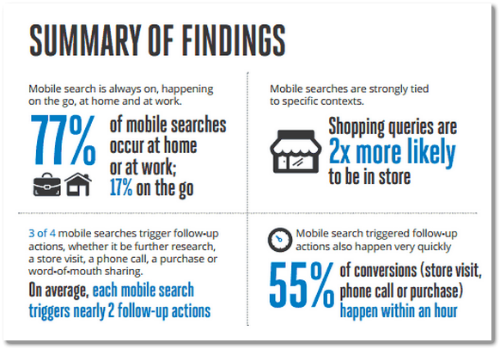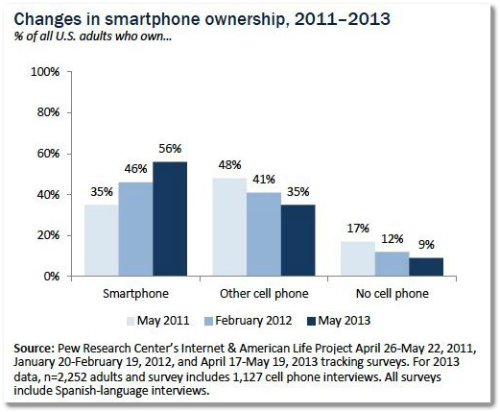More than half the people you meet on a daily basis own a smartphone.
In an IDC study sponsored by Facebook entitled “Always Connected: How Smartphones and Social Keep Us Engaged,” nearly 80{0a8e414e4f0423ce9f97e7209435b0fa449e6cffaf599cce0c556757c159a30c} of respondents reported that their smartphone was within hands reach for all but two hours of their waking day.
More importantly, smartphone adoption rates continue to increase across all demographic metrics.
If a real estate professional knows how to properly leverage mobile technology they can truly standout in the global and local marketplace.
Having a comprehensive mobile presence that engages consumers is not just important, it’s crucial for any modern enterprise. However, before potential customers are engaged with your amazing mobile experience, they first have to find you. So how can you gain a mobile marketing edge in yoru business?
Mobile and Search
In March, Google released a report entitled “Mobile Search Moments: Understanding how Mobile Drives Conversions” which analyzed 6000 mobile search results.

They found that 73{0a8e414e4f0423ce9f97e7209435b0fa449e6cffaf599cce0c556757c159a30c} of mobile searches resulted in additional action related to the search. Nearly 1/3 of consumers went on to do further research with the company they were interested in and 36{0a8e414e4f0423ce9f97e7209435b0fa449e6cffaf599cce0c556757c159a30c} of them made a purchase of one kind or another.
Simply put, people who search on mobile devices are engaged whenever and wherever they are.
Rich Snippets and Geotags
One of the most important things an agent or broker can do to make their search results stand out is to ensure that when someone Google’s them it results in something called a “rich snippet.” A snippet is that small piece of information that shows up under the blue link of a search result.
A rich snippet is one where an image, video, or map might show up next to that link. In an industry that is as competitive and hyperlocal as real estate, these types of search result enhancements can be major drivers of business.
These enhanced search results are effective because they allow people to see a detailed preview of the site they are about to visit. The link with the small video next to it is statistically more likely to drive traffic because it provides value to the consumer before they ever make it to the site.
One of the more powerful ways to enhance a local search result with a rich snippet is through something called a “geotag”. A geotag is a specific piece of data that is added to a webpage about a business’s physical location in the world.
These types of tags can be and should be tied directly to all of a company’s listings. If geotags have been properly deployed, when a potential customer searches for a new home through their mobile device they will see the home’s location information in a small map at the top of the search window.
To be fair though, any business with or without geotagging will get a small map produced without geotagging. So why do this? First, by providing search engines with your location information you are taking ownership of the data that is displayed through a search. This is especially crucial for listing locations as that realtor now “owns” that specific geo-location despite the property being listed on a wide variety of other sites.
Secondly and more importantly, if someone is looking for companies in your field and you have geotagged your site, there is a strong possibility that your site will appear higher up in the search results than a competitor based on location. Last but not least, you can actually improve your local search results just by taking a picture of your business or listing and geotagging it.
Show Up in Local Search
Geotagging is a great way to make sure that your company’s information shows up in local searches. Another technique for engaging your local market is geo-fencing. Geo-fencing is a way to market to people in your local area based on the location information stored in their phones. This requires customers to “opt-in” to receive ads from a company via a mobile notification.
Once registered, the process will prompt a nearby user with an advertisement or information whenever they are within a designated range of a business or listing that has been ‘geo-fenced.’Putting ads directly into consumers’ hands when they are physically close to a business has shown promise when it is done effectively.
The real advantage of implementing a geo-fencing program is that it allows you to spend your marketing resources when it is most likely to result in the strongest return on investment.
Stand Out in Your Local Market
Real estate professionals that are interested in standing out in their local market should be producing quality content on a regular basis through a blog that provides valuable information to their customers. In order to make that content attract attention, another type of rich snippet called Google Authorship can add an agent’s picture right next to an article in the search results page.
Agents who can anticipate their customers’ needs and deliver helpful and pre-emptive blog articles about the state of the local market, will continue to draw new business from their content.
So if a customer searches for homes in your area they might see your article pop up with your picture next to it talking about changes in the local housing market.
These are just a few of the ways that agents and companies can use mobile technology to differentiate themselves. As more people interact with the web through their smartphones and tablets, it will take a nimble business to figure out the best way to meet the needs of both their global and local consumers.
[ois skin=”Subscribe 1″]










